What is the scheme of the toilet cistern: eliminate the
If at your home or at work the toilet cistern has broken, then it can be repaired in almost 90% of cases, and more often it doesn’t have to be a mechanic or an over-the-cloud discharge worker. But in order to make any repairs in any device, you need to at least understand how it works and what it consists of.
We want to bring to your attention the main types of tanks and briefly talk about their work, as well as demonstrate the video in this article.
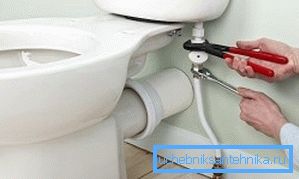
Tanks for flushing
How it works
Note. Among the many models, the principle of operation of the toilet cistern always remains the same - water is drawn into the tank to a certain level and is discharged using a mechanism that is actuated by a lever or a rod.
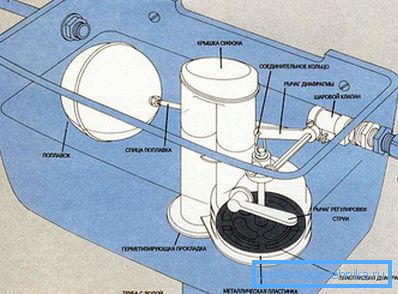
- Despite the fact that the cisterns can function by means of mechanisms that are very different in appearance, they nevertheless serve the same purpose - flushing of sewage from the toilet bowl. In addition, any of these units is mounted only above the toilet bowl, that is, on its dish-shaped shelf, on a wall or in a niche (it can be on the side).
- Now let's see how the toilet cistern works with any design and functionality of valves. First of all, water is supplied to the tank from the pipeline (from the side or from the bottom), the flow of which is regulated (closed-opens) by either a shut-off valve or a ball valve.
- The water level in the tank is controlled by a float, which is in one way or another connected by a lever with a shut-off valve - when the water level rises, the float rises along with it, dragging the valve. Thus, the distance between the through-hole and the plug is reduced until the hole is completely blocked.
- Further, the instruction provides for a side lever, or a rod with a button / key or a ball for forcing the opening in the bottom of the cistern - water is discharged into the toilet. The valve in the lower (discharge) part of the tank can also be different, but its function is always the same, and in the closed position it is held by gravity forces.
Old Style Tanks

To begin with, let's see how to distinguish the designs of the old model from the new ones, and it does not even need any special knowledge, as there are very clear visual and technical signs.
- First of all, in older models, the tank is made of cast iron or earthenware (the height of grace and pretentiousness).
- Secondly, Such containers are drained either by a side lever or by a central rod, but not by pressing a button, but by raising this stem with the help of a ball on it.
As you understand, during the times of the USSR utilitarian premises, to which the toilet was also referred, did not even occur to anyone to equip them with the use of modern design. As a result, the population received from the industry plumbing without any frills - it was just a tank for water and nothing more.

Older units have a fairly simple design, and water is discharged through a large-diameter discharge siphon, where there is a plastic or rubber valve and at first glance you can even confuse it with a plunger. The stem from this valve is brought to the side handle, which serves as a lever, that is, this handle has a central vertical support.
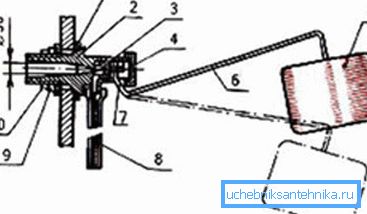
The shut-off valve on the water supply to the tank here functions according to the general principle - when the water level rises, the float rises along with it, dragging the valve, and the latter, aligning vertically from an inclined position, closes the water supply hole.
When water is discharged from the reservoir, the float is lowered, opening the valve, and the entire replenishment process is repeated again.
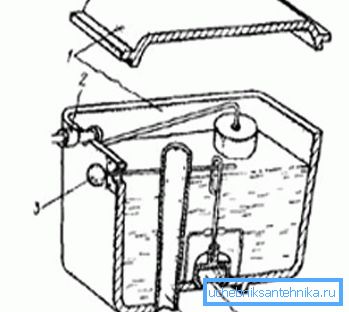
Despite the fact that such draining tanks are rather bulky, nevertheless, they are very reliable and easily repaired, as there you can replace any part or even make it yourself. There are no modules there, and very small details are missing and, as a result, you can see old-style tanks in some apartments, which are already 40-50 years old.
Modern models

In modern cisterns with one (see photo above) or two buttons (keys), the process of water intake and dropping occurs exactly as in the old models, only their appearance is much more attractive, and they fit perfectly into the bathrooms decorated with ceramic tiles.
Moreover, they even look like a part of a whole in a toilet or bathroom, and their price is, of course, much higher.
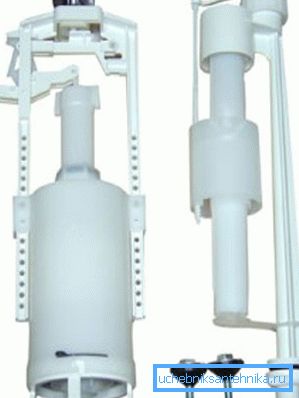
But the changes did not occur only in the design - shut-off valves became completely new, and in the event of a breakdown of a node, you just need to replace the entire module, that is, individual parts, such as the float, check valve or rod / lever, cannot be replaced.
The block is provided with a thread, that is, when it is fastened in a vertical position, it turns out, as if on a stretch - nut devices are screwed on the lid and at the bottom. The module of the shut-off valve on the water supply has a separate assembly, but it is not sold separately - all the valves for the toilet cistern are sold in the kit and it is inexpensive because plastic is cheaper.
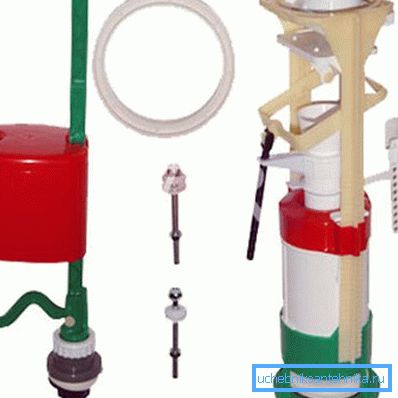
In fact, the same principle of operation and the module with a double valve, only in this case there are two modes of water discharge - one is full and the other half, so if the average volume of a large drain is 7-8 liters, then a small drain has 3 , 5-4 liters, but these indicators are regulated.
So if water does not flow into the toilet cistern, then the problem is most likely in the adjustment or failure of the shut-off valve. But in most cases it is much easier to simply replace the stop valve module for the toilet bowl.
Note. For cafes, bars and restaurants, as a rule, they install tanks with double drain, which do not have adjustment. For private use, such models are not very convenient and precisely because of the lack of adjustment.
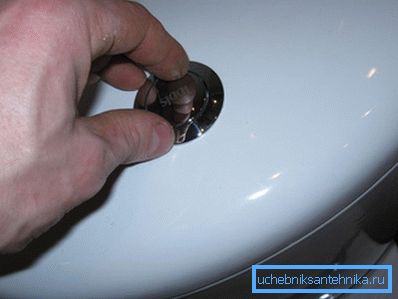
But to replace such a module for most users, the question arises, how to disassemble the toilet cistern if there are no bolts, nuts and screws? All this is done very simply - you just need to unscrew the buttons along with the nut (this is a small module block) counterclockwise and the cover is removed.
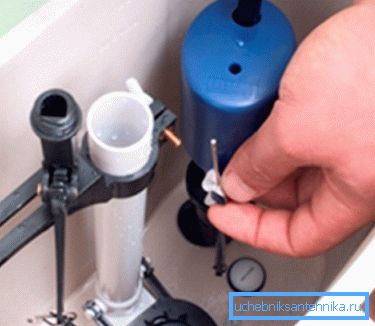
If you are interested in how to adjust the toilet cistern, then you need to change the position of the float, that is, move it on the toothed stem up or down. The lower it is, the lower the water level in the tank will be.
Conclusion
If the toilet cistern leaks water into the toilet itself, then the problem is most likely in the overflow and you need to lower the float below. But if water flows down the disc shelf or comes out from under the mounting bolts, then you have to remove the tank and put all the fasteners (gaskets) on the silicone sealant.